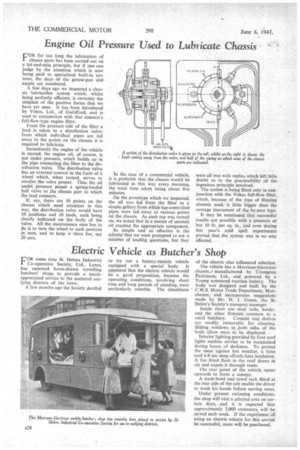Engine Oil Pressure Used to Lubricate Chassis
Page 30

If you've noticed an error in this article please click here to report it so we can fix it.
FOR far too long the lubrication of chassis parts has been carried out on a hit-and-miss principle, but if one can judge by the attention which is now being paid to specialized built-in systems, the days of the grease-gun and nipple are numbered.
• A few days ago we inspected a chassis• lubricatfun system which, whilst being perfectly efficient, is certainly the simplest of the positive forms that we have yet seen. It has been introduced by Vokes, Ltd., of Guildford, and is used in conjunction with that concern's full-flow-type engine filter.
From the pressure side of the filter a
lead is taken to a distribution valve;•from which individual pipes are led
away to the points on the chassis it is required to lubricate.
Immediately the engine of the vehicle is started, the engine oil, of course, is put under pressure, which builds up in the pipe connecting the filter to the distribution valve. The distribution valve has an external control in the form of a Wheel which, when turned, serves to revolve the valve proper. Thus the oil under pressure passes a spring-loaded ball Valve to the chassis part to which the lead connects.
If, say, there are 10 points on the chassis which need attention in this way, the distribution valve would have 10 positions and 10 leads, each being clearly indicated on the body of the valve. All the maintenance man has to do is to turn the wheel to each position in turn, and to keep it there for, say 20 secs. In the case of a commercial vehicle, it is probable that the chassis would be lubricated in this way every 'morning, the total time taken being about five minutes.
On the prototype which we inspected, the oil was led from the filter to a simple gallery from which tap-controlled pipes were led away to various points on the chassis. As each tap was turned on, we noted that in a matter of seconds oil reached the appropriate component.
So simple and so effective is the scherne that we were prompted to ask a nUmber of leading questions, but they were all met with replies which left little doubt as to the practicability of the ingenious principle• involved.
The system is being fitted only in conjunction with the Vokes full-flow filter, which, because of the type of filtering element used, is little bigger than the average instrument of the by-pass type.
It may be mentioned that successful results are possible with a pressure of but 10 lb. per sq. in., and even during this year's cold spell experiments proved that the system was in no way affected.












































































